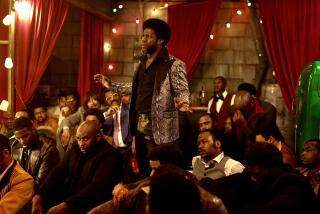Review: Four legends walk into a motel room in Regina King’s superbly acted ‘One Night in Miami ... ’
The first time we see the four protagonists together in “One Night in Miami ... ,” Regina King’s terrifically sharp directing debut, they aren’t just in any old room. It’s Feb. 25, 1964, at the Miami Beach Convention Hall, where a 22-year-old boxing star named Cassius Clay (Eli Goree) is about to pull off his first famous victory over Sonny Liston. Every so often the camera cuts away from this sweat-and-blood spectacle to sweep through the electrified crowd, catching glimpses of Jim Brown (Aldis Hodge), rattling off feverish commentary on Cassius’ every move, and of Malcolm X (Kingsley Ben-Adir) and Sam Cooke (Leslie Odom Jr.) as they cheer loudly from their seats. The four are united by friendship and by the palpable excitement of the moment. They’re also united by their understanding of what it means to be a Black man in the spotlight, with its conditional blessings and impossible burdens.
Crisply adapted by Kemp Powers from his one-act stage play, “One Night in Miami ... ” is a deconstruction of Black success that opens on a pointed note of failure. It begins with Cassius getting famously dropped by Henry Cooper in 1963, then moves on to find Sam crooning — and bombing — before a visibly unimpressed Copacabana crowd. We see Jim stop by a Georgia plantation to visit an old family associate (Beau Bridges) and learn, to his silent fury, that even being an NFL superstar isn’t enough for him to be regarded in the eyes of some as fully human. In telling contrast, Malcolm, the last of the four, is first seen at home with his wife, Betty X (Joaquina Kalukango), far from the judgmental eyes of white men whose approval he has no interest in soliciting.
These opening scenes, introducing the characters in sweeping succession, serve as a prelude to the main action and offer some visual variety before the enforced claustrophobia that is about to follow. (They also allow us to appreciate the resourcefulness and the gorgeous sheen of Barry Robison’s mid-’60s production design.) But these scenes also deftly establish the movie’s thematic preoccupations and its symphonic structure: Here are four famous Black men whose period of ascendancy has coincided with that of the civil rights era, and whose experiences, however distinct, will throw each other into sharp, clarifying relief.
Like the play, the movie offers a fictionalized, speculative account of a gathering at the Hampton House Motel, a longtime oasis for Black tourists in still-segregated Miami Beach. (The movie was shot in New Orleans.) They have gathered here after that history-making first Clay-Liston bout, though for rather different reasons. Sam and Jim are hoping to drink, unwind and enjoy a night of easygoing hedonism in one of America’s great party cities. Malcolm and his spiritual protégé, Cassius, have more serious concerns as they prepare to announce the latter’s conversion to Islam. There’s some lighthearted sparring — the puritanical Malcolm has brought ice cream instead of booze — but the funny, celebratory mood soon turns tense as words become weapons and a one-room four-hander transforms itself, via King’s fluid, elegant direction, into a rhetorical action movie.
You might be reminded of those early boxing scenes, given the pugilistic rhythms of the conversation, with Malcolm and Sam playing the antagonistic heavyweights while Jim and Cassius squirm and smooth things over from the sidelines. It doesn’t take long for Malcolm to call Sam a “windup toy in a music box,” pandering to white mainstream tastes with his crowd-pleasing, chart-topping singles at the expense of the Black man’s freedom. Nor does it take long for Sam to imply that Malcolm is a self-righteous killjoy, too invested in his narrow vision of liberation to grasp that the freedom that matters most to their community — economic mobility — is what Sam, more than any of them, has in abundance.
Does that particular liberty come at too great a political cost? At one point, Malcolm puts on a Bob Dylan record to score a harsh point, pointing out that the enormous success of “Blowin’ in the Wind” would seem to refute Sam’s contention that songs of protest are commercially unviable. (The obvious rebuttal — that the mainstream has awfully blinkered views of whose protest gets to be heard and validated — goes unstated.) This musical interlude, occurring about halfway through a movie bookended and periodically interrupted by Sam’s (which is to say Odom’s) velvety-smooth singing, is instructive. If “One Night in Miami ... ” salutes Ali’s athleticism by taking place in a verbal boxing ring, it honors Sam no less by transforming its dialogue into a kind of music, delivered by a quartet of actors who never strike a false note.
King, who has been directing television for years, in some ways fulfills the truism that actors-turned-filmmakers tend to bring out the best in their performers, though she notably does this with discipline rather than indulgence. (Her collaborators here include cinematographer Tami Reiker and editor Tariq Anwar, both working with unerring precision.) The suspension of disbelief that any celebrity impersonation requires may be multiplied fourfold here, but “One Night in Miami ... ” turns that excess into a kind of economy. It moves, with light-fingered assurance, through sequences that transform from soulful arias into sustained duets, built around performances that are collaborative rather than imitative in nature.
Goree is particularly touching as Cassius, the naive, eager-to-please baby of this particular group, though outwardly he already evinces the outspokenness and swagger for which the future Muhammad Ali will be known. Hodge, fast becoming one of the most watchable actors around (“Clemency,” “The Invisible Man”), is a charismatically recessive presence, more peacemaker than provocateur. But that makes it unexpectedly stinging — and satisfying — when Jim rises in Sam’s defense and casually hits Malcolm with one of the script’s sharpest blows: “I always find it funny how you light-skinned cats wind up being so damn militant.”
The debate that ensues from that one remark is just one example of how “One Night in Miami ... ” chips away at any simplistic, monolithic conception of Black identity. (In this, it shares something with another recent screen-to-stage period drama, “Ma Rainey’s Black Bottom,” and also with the Pixar animation “Soul,” which Powers co-wrote and co-directed.) These friends spar playfully, and sometimes furiously, over many oppositional subjects: art and commerce, assimilation and isolation, passivity and militancy, the spiritual and the secular. They argue about the Beatles, the Rolling Stones and JFK. They talk about the racism they encounter and deflect on a daily basis and the double-edged sword of celebrity, of achieving excellence in a country where excellence is defined as an exclusively white virtue.
How overtly, and effortfully, should they position themselves in defiance of that bigoted logic? Must popular success always make one a sellout, and does rejecting that success ensure one’s integrity? The wit and the compassion of “One Night in Miami ... ” lie in its refusal of easy answers, which is to say its recognition that the answers are different for everyone, as you can see from the passion and ambivalence with which each man regards his particular cultural sphere. That’s Hollywood for Sam, and maybe also for Jim, who has just shot a role in a western, “Rio Conchos,” and is eyeing a long-term movie career. For Malcolm, it’s the Nation of Islam, though his growing estrangement from the movement is becoming increasingly difficult to keep secret — and is a major reason why he’s so intent on bringing Cassius into the fold.
But Ben-Adir’s performance as Malcolm — this British actor’s latest sensitive rendering of an American icon, after playing President Obama in “The Comey Rule” — hints at a less calculated, more emotional motive. The film’s most uncompromising voice might also be its most vulnerable: With a voice that can be forceful and softly cajoling by turns, Ben-Adir calls attention to Malcolm’s fear and loneliness, his awareness that, because of his insistence on separatism and self-determination, he’s the one member of this quartet who doesn’t fully belong. His passion for photography underscores this point: Snapping pictures of the other three, he’s often the one left on the outside looking in.
He and Sam make a terrific pair of foils, and Odom, no less than when he played Aaron Burr in “Hamilton,” shifts vigorously between offense and defense. The rapport between Malcolm and Sam is haunted by the specter of death, acknowledged explicitly in the case of Malcolm, who would be murdered barely a year later, and tacitly for Sam, who would meet his own violent end even sooner. The poignant gesture that finally connects these two men, closer brothers under the skin than they realize, raises a question that stems from their very different talents: Can you provoke and entertain in the same instance? Can you please a crowd and also make them think? “One Night in Miami ... ” answers movingly and undeniably in the affirmative.
‘One Night in Miami ... ’
Rating: R, for language throughout
Running time: 1 hour, 54 minutes
Playing: Starts Jan. 8 at Mission Tiki Drive-In Theatre, Montclair, and Vineland Drive-In, City of Industry; also available on Amazon Prime Video
More to Read
Only good movies
Get the Indie Focus newsletter, Mark Olsen's weekly guide to the world of cinema.
You may occasionally receive promotional content from the Los Angeles Times.










